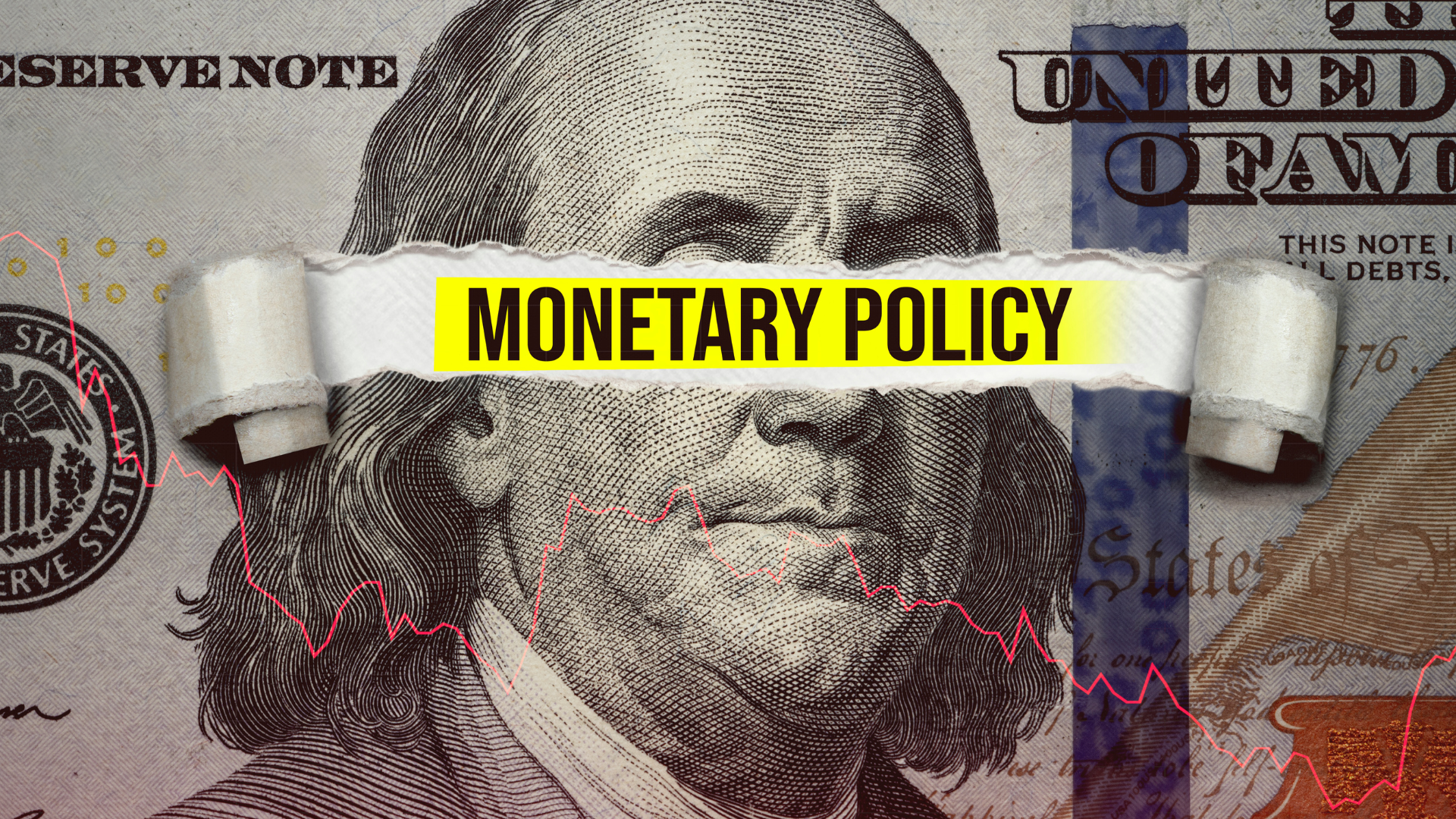What is Monetary Policy?
Monetary policy tools, such as interest rate adjustments, reserve requirements, and market interventions, enable central banks to influence economic activity for price stability and employment goals.

Monetary policy is a set of tools that a central bank has at its disposal to influence the level of economic activity. These tools include adjusting the policy interest rate, reserve requirement ratio, the exchange rate and the conduct of financial market interventions to help achieve the central bank’s objectives of price stability and maximum employment.
Unlike fiscal policy which is decided by politicians, monetary policy is decided by a central bank’s monetary policy committee whose members are apolitical. Monetary policy is normally decided at scheduled meetings. However, in times of crisis or extreme levels of financial volatility, monetary policy may be adjusted in between scheduled meetings.
Financial market participants scrutinise the monetary policy statements and comments made by the central bank and its chairman after each policy meeting as the monetary policy decisions taken by the central bank have a broad impact on the financial markets and the wider economy.
Objectives of Monetary Policy
The goals of monetary policy are to maximise employment while keeping prices stable.
Maximum employment refers to the highest level of employment that an economy can withstand without generating unwelcomed inflationary pressures. In economics, this is termed as full employment. An overheated economy operating at above full employment will often result in rising rates of inflation.
Price stability refers to keeping inflation under control. Most central banks have a mandate of keeping inflation at around the 2% mark. Price stability is important as it gives individuals and businesses a higher degree of certainty when they are making borrowing, savings, and investment decisions. This certainty helps to promote sustainable economic growth.
Sign Up at RealVantageHow does Monetary Policy work?
Monetary policy can affect the level of economic activity via adjusting the reserve requirement ratio, policy interest rates, and the conduct of open-market operations. In the case of Singapore, monetary policy is carried out by the Monetary Authority of Singapore (MAS) through the foreign exchange market.
Reserve requirement ratio
The reserve requirement ratio is the total amount of funds banks must have on hand as a percentage of its customers’ deposits. This requirement is in place to ensure that banks always have funds to meet customers’ withdrawals. By changing this ratio, the central bank can influence the ability of banks to lend. A decrease in the reserve requirement ratio increases the amount of funds available in the banking system to lend to consumers and businesses. An increase in the reserve requirement ratio on the other hand reduces the amount of money banks can lend. More bank lending increases the level of economic activity and vice versa.
Policy Interest rates
The policy interest rate of most developed nations is the overnight interbank rate. This is the interest rate banks who are short of reserves have to pay banks who have excess reserves for overnight borrowing. This interest rate is a target set by the central bank. The overnight interbank rate directly affects the banks’ prime lending rate, the interest rate banks charge their best customers. In addition, the prime rate also affects the interest rate on adjustable-rate mortgages, credit card loans and car loans. Therefore, a higher policy interest rate will suppress demand for loans and hence result in lower expenditure and investment by consumers and businesses.
Read also: Understanding the SIBOR
Read also: Singapore New Benchmark Interest Rate SORA Explained
Open-market operations
Open market operations involve the buying and selling of short-term government securities such as treasury bills by the central bank. When the central bank purchases short-term government bonds, it increases the level of reserves in the banking system , resulting in more money available for lending. Central banks can also specifically lower long-term interest rates by carrying out l quantitative easing, which is the purchase of longer dated securities such as government bonds and mortgage back securities. Lower yields on government bonds will exert downward pressure on other longer term interest rates such as corporate bonds, and fixed rate mortgages, encouraging businesses to invest more and consumers to buy more homes, lifting economic activity.
Read also: Understanding More about Singapore Savings Bonds
Exchange Rate
Monetary policy in Singapore is centred around the exchange rate. With a small and open economy where the gross exports and imports of goods and services exceed 300 percent of GDP and where domestic expenditure has a high import content, the exchange rate is the more effective tool than the interest rate for maintaining price stability. MAS monetary policy framework is centred on managing the value of the Singapore dollar against its trading partners. The primary tool for managing the trade weighted value of the Singapore dollar (also known as the Net Effective Exchange Rate) is through intervention in the spot foreign exchange market with the sale or purchase of the Singapore dollar against the US dollar. A stronger Singapore dollar will weaken exports and strengthen imports, dampening economic activity. Conversely, a weaker Singapore dollar will strengthen exports and weaken imports, stimulating our economy.
Different Types of Monetary Policy

There are two main types of monetary policy: expansionary and contractionary monetary policy.
Expansionary Monetary Policy
Expansionary monetary policy aims to increase economic activity by reducing interest rates and lowering the reserve requirements for banks. Buying of securities such as treasury bills by central banks increases the reserves in the banking system and hence the amount of funds available for loans. Falling interest rates lead to higher levels of capital investment and make domestic bonds less attractive, hence demand for foreign bonds increases. Subsequently, demand for foreign currency rises, causing a decrease in the exchange rate. This leads to higher exports and lower imports, which increase the balance of trade.
Expansionary monetary policy is implemented to lower unemployment rates, stimulate business activities and promote consumer spending during a slowdown or recession. The overall objective is to drive economic growth and activity, but overdoing it will result in the economy to overheat, leading to higher inflation.
Contractionary Monetary Policy
Contractionary monetary policy aims to decrease the level of economic activity by raising interest rates and increasing the reserve requirements for banks. Central banks sell securities to banks and decrease the reserves in the banking system and hence the amount of funds available for loans. Rising interest rates lead to lower levels of capital investment and make domestic bonds more attractive, hence demand for domestic bonds surge. Subsequently, the demand for domestic currency rises, causing an increase in the exchange rate. This leads to higher imports and lower exports, which reduces the balance of trade.
Contractionary monetary policy is implemented to lower inflation levels and tackle the issue of rising costs of living and business costs. The overall objective is to reduce inflation and to restore price stability, but overcooling the economy may result in a recession.
Sign Up at RealVantageWhat are Examples of Monetary Policy?
During the financial crisis and global recession of 2008 to 2009, the U.S. Federal Reserve adopted an expansionary monetary policy approach by lowering interest rates to near zero, and eased the availability of credit to financial institutions and markets. The Fed also expanded its open-market operations to large-scale purchases of treasury bills and longer-term Treasury debt in what became known as quantitative easing.
In the mid to late-1970s, inflation levels in the U.S. spiralled, hitting 15%. The Fed took actions to target the money of supply by controlling non-borrowed reserves, and increased its benchmark interest rate to 20%. While high interest rates led to a recession, price stability was restored.
Is Monetary or Fiscal Policy Better?
Fiscal policy is the use of government spending and taxation policies to impact aggregate demand.
There are similarly two types of fiscal policy: expansionary and contractionary fiscal policy. Expansionary fiscal policy boosts the economy by lowering taxes and increasing consumers’ spending power, which fuels consumer expenditure. Government spending is also increased to further stimulate the economy. On the other hand, contractionary fiscal policy is designed to slow economic growth to counter high inflation. Taxes are raised and government spending is cut to rein in high inflation rates.
The drawback of expansionary fiscal policy is the mounting deficit that may eventually lead to fiscal austerity with severe consequences. Similarly, contractionary fiscal policy is characterised by high political costs and thus hugely unpopular with politicians and voters.
Ultimately, both monetary policy and fiscal policy serve similar purposes in helping the government to achieve its economic objectives. Monetary policy is more commonly used to ‘fine-tune’ the economy via changes to interest rate, and preferred over fiscal policy for restraining high inflation due to the political unpopularity of contractionary fiscal policy. But in circumstances such as deep recessions, limitations of monetary policies will show as slow real GDP growth and high unemployment rate persists, hence an expansionary fiscal policy will be required to boost overall confidence in the economy.
About RealVantage
RealVantage is a leading real estate co-investment platform, licensed and regulated by the Monetary Authority of Singapore (MAS), that allows our investors to diversify across markets, overseas properties, sectors and investment strategies.
The team at RealVantage are highly qualified professionals who brings about a multi-disciplinary vision and approach in their respective fields towards business development, management, and client satisfaction. The team is led by distinguished Board of Advisors and advisory committee who provide cross-functional and multi-disciplinary expertise to the RealVantage team ranging from real estate, corporate finance, technology, venture capital, and startups growth. The team's philosophy, core values, and technological edge help clients build a diversified and high-performing real estate investment portfolio.
Get in touch with RealVantage today to see how they can help you in your real estate investment journey.
Disclaimer: The information and/or documents contained in this article does not constitute financial advice and is meant for educational purposes. Please consult your financial advisor, accountant, and/or attorney before proceeding with any financial/real estate investments.
